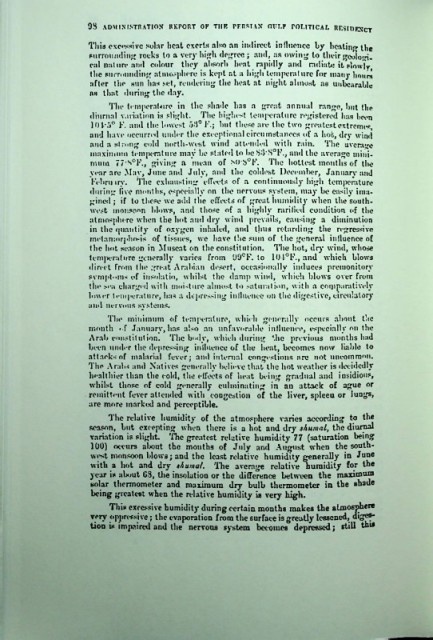Page 346 - PERSIAN GULF ADMINISTRATION REPORTS V1
P. 346
OS ADMINISTRATION REPORT OK THE PERSIAN fllll.F rOT.lTICAL RESIDENCY
Tliis excessive solar heat exerts also an imlircct influence by beating the
surrounding rocks to a very high degree; and, as owing to their geologi
cal nature and colour they absorb beat rapidly and radiate it slowly,
the surrounding atmosphere is kept at a high temperature for many hours
after the Him has set, rendering the heat at night almost as unbearable
as that during the day.
The temperature in the shade has a great annual range, hut the
diurnal variation is slight. The highest temperature registered hits been
] 0 K»° F. and the lowest 5*1° K; hut these are the two greatest extremes,
and have occurred under the exceptional circumstances of a hoc, dry wind
and a strong cold north-west wind attended with rain. The average
maximum temperature may he stated to bc33'80F., and the average mini
mum 77 S»CT\, giving a mean of The hottest months of the
year are May, June and July, and the coldest December, January ami
Fchru irv. The exhausting effects of a continuously high temperature
during five months, especially on the nervous system, may be easily ima
gined ; if to these we add the effects of great humidity when the south
west monsoon blows, and those of a highly rarified condition of the
atmosphere when the hot and dry wind prevails, causing a diminution
in the quantity of oxygen inhaled, and thus retarding the regressive
metamorphosis of tissues, we have tlie sum of the general influence of
the hot season in Muscat on the constitution. The hot, dry’ wind, whose
temperature generally varies from U9°F. to 1U1°F., and which blows
direct from the great Arabian desert, occasionally induces premonitory
sympt"in< of insolatio, whilst the damp wind, which blows over from
the mm charged with mni-ture almost to saturation, with a comparatively
lower temperature, has a depressing influence on the digestive, circulatory
and nervous systems.
The minimum of temperature, which generally occurs about the
month . f January, has also an unfavorable influence, especially on the
Arab constitution. The body, which during the previous months had
been under the depressing influence of the heat, becomes now liable to
attacks of malarial fever; and internal congestions are not uncommon.
The Arabs and Natives generally believe that the hot weather is decidedly
healthier than the cold, the effects of heat being gradual and insidious,
whilst those of cold generally culminating in an attack of ague or
remittent fever attended with congestion of the liver, spleeu or lungs,
are more marked and perceptible.
The relative humidity of the atmosphere varies according to the
season, but excepting when there is a hot and dry shumal, the diurnal
variation is slight. The greatest relative humidity 77 (saturation being
100) occurs about the months of July and August when the south
west monsoon blows; and the least relative humidity generally in June
with a hot and dry thumal. The average relative humidity for the
year is about 63, the insolation or the difference between the maximum
solar thermometer and maximum dry bulb thermometer in the shade
being greatest when the relative humidity is very high.
This excessive humidity during certain months makes the atmosphere
very oppressive; the evaporation from the surface is greatly lessened, diges
tion is impaired and the nervous system becomes depressed; still this

